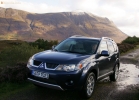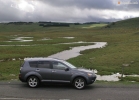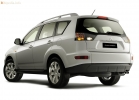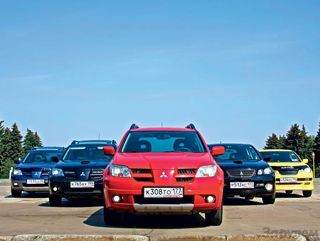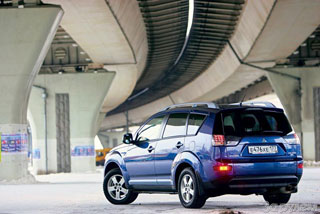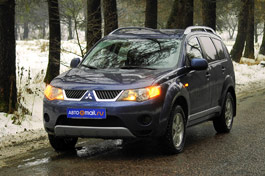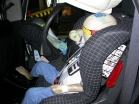Mitsubishi Outlander test drive since 2007 SUV
Mitsubishi Outlander XL
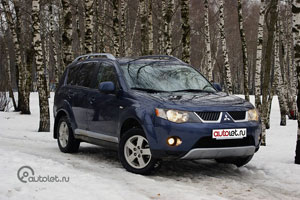 Where does these letters XL come from here, indicating an increased dimension? Does this mean that there is the same product with dimensions more modestly say, l or m? It usually happens, but not in our case. The explanation of the simple Outlander of the previous generation, the model of 2004, has not yet been removed from production, and the novelty must be somehow denoted. And since it turned out to be a little larger, she was called XL.
Where does these letters XL come from here, indicating an increased dimension? Does this mean that there is the same product with dimensions more modestly say, l or m? It usually happens, but not in our case. The explanation of the simple Outlander of the previous generation, the model of 2004, has not yet been removed from production, and the novelty must be somehow denoted. And since it turned out to be a little larger, she was called XL. In general, the appearance of this model can be considered early. After all, the last car with the same name cannot be called unsuccessful or outdated only 3 years in the market. In part, therefore, the novelty did not come to a replacement, but in addition to the first six months, it was offered only with a three -liter engine and automatic transmission. And now a version with a well -known Mitsubishev engine of 2.4 liters (170 hp) has entered the market. But for XL, it is equipped with both mechanics and a unavailable CVT box (which is unusual for the brand!).
Name the modification of 2.4 of the budget language does not turn. Not at a price from 936,000 to 1.060,000 rubles. Not a set of advantages. The Rockford Fosgate Acoustic musical system alone in the maximum confusion configuration is worth it! Even much more expensive than Outlander, I do not remember such a quality of sound. The sound is fantastically voluminous and natural not a salon, but a music room! And in the corner of the trunk, a 650-vat subwoofer lurked.
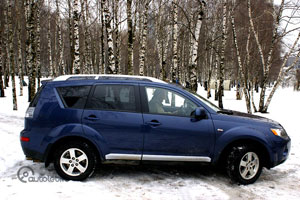 Yes, by the way about the trunk. The predecessor of his modest volume was almost the main drawback of this, all experts and tests found fault with this. But in the novelty of the XL, the trunk became even extremely deep and quite convenient (although its threshold could be lower!).
Yes, by the way about the trunk. The predecessor of his modest volume was almost the main drawback of this, all experts and tests found fault with this. But in the novelty of the XL, the trunk became even extremely deep and quite convenient (although its threshold could be lower!). And along the cabin, all geometric parameters are good in the second row to sit spacious even the three of them, and it is quite easy to climb there. At the same time, Mitsubishi Outlander XL got rid of one characteristic, but annoying family deficiency. For many models of the brand, the middle head rest in the rear seat had such gigantic sizes that it overlapped the significant and most relevant part of the viewing sector through the intra -junction mirror. It remained or more actively using the side mirrors (which, you see, is strange in a passenger car), or to remove this attribute of passive safety (after all, the average passenger rarely rides behind). Now, all three head restraints of the back row can be lowered so down, having stuck in the back of the seat, that they do not interfere with the review. And to raise as they fill the salon by people!
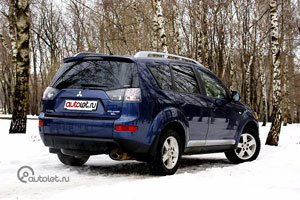 The decoration of the salon, falling into the field of view of the front sidelines, was previously very ascetic (but by no means stingy or wretched!). The XL is decorated, but still the principles of reasonable minimalism and unified stylistics are favorably distinguished by Mitsubishi against the background of many other Japanese brands. But the main thing that is present is three classic climate control handles. The temperature is a blow-to-administration of blowing a better one who has not come up with this yet. All these placers of buttons or entrance through a computer menu from the evil one looks rich, and use is inconvenient. Everything is at hand here. Perhaps, except for one handle of the parking brake, it huddles closer to the passenger seat. Another remark is the lack of adjustment of the steering column by departure. But, unlike most competitors with the same drawback, the position of the steering wheel is not too far from the driver. The steering wheel itself is beyond praise with the buttons of music management, Hands Free and Cruise Control. The rim is pleasantly in the hands and does not overlap the dashboard.
The decoration of the salon, falling into the field of view of the front sidelines, was previously very ascetic (but by no means stingy or wretched!). The XL is decorated, but still the principles of reasonable minimalism and unified stylistics are favorably distinguished by Mitsubishi against the background of many other Japanese brands. But the main thing that is present is three classic climate control handles. The temperature is a blow-to-administration of blowing a better one who has not come up with this yet. All these placers of buttons or entrance through a computer menu from the evil one looks rich, and use is inconvenient. Everything is at hand here. Perhaps, except for one handle of the parking brake, it huddles closer to the passenger seat. Another remark is the lack of adjustment of the steering column by departure. But, unlike most competitors with the same drawback, the position of the steering wheel is not too far from the driver. The steering wheel itself is beyond praise with the buttons of music management, Hands Free and Cruise Control. The rim is pleasantly in the hands and does not overlap the dashboard. 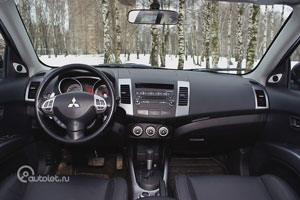 From a sled point of view, Outlander is close to the standard. Firstly, the thrust is great, the feedback to press the gas pedal is simply instantaneous. You can’t even say that there are only 2.400 cubic meters! Where else? Light, as if blowing a fair wind, accelerations do not overshadow the hysterical trifles of the engine, as often happens, especially with variator KP. Manual control of the CVT pseudo -transmission allows you to accelerate a shade of personal involvement in the process, and at the same time makes it possible to slow down, especially on the descents. The usual brake dynamics (pah-pah-pah!) It is also more effective than the expected result. The brake pedal here is light and transparent in terms of efforts.
From a sled point of view, Outlander is close to the standard. Firstly, the thrust is great, the feedback to press the gas pedal is simply instantaneous. You can’t even say that there are only 2.400 cubic meters! Where else? Light, as if blowing a fair wind, accelerations do not overshadow the hysterical trifles of the engine, as often happens, especially with variator KP. Manual control of the CVT pseudo -transmission allows you to accelerate a shade of personal involvement in the process, and at the same time makes it possible to slow down, especially on the descents. The usual brake dynamics (pah-pah-pah!) It is also more effective than the expected result. The brake pedal here is light and transparent in terms of efforts. One of the main features of the XL, unlike the previous Outlander, was a refusal (alas!) From a constant all -wheel drive. Between the seats there is a round handle 2 WD-4WD-Lock. With the first position, everything is clearly going on the front drive. With the latter, too, blocking the center differential allows you to get out of the most difficult situations. But the 4WD symbol does not mean that you are moving with a permanent all-wheel drive. This is just a hypothetical possibility of transferring part of the torque to the rear axle. But the connection of 4x4 is so soft and unobtrusive that the driver does not notice this. And with the slightest slip of the front, the rear wheels are included in the process so quickly that you involuntarily ask the question of why, even on other cars, even along a dry, even road, you need to constantly push off all four wheels?
What else is important for the user? Well, such a parameter, for example, as efficiency. So, I responsibly declare that Mitsubishi Outlander XL is much less voracious than most of its counterparts. In real city mode, you will meet 13-14 liters per hundred. And with uniform driving along the highway, the indicators of the tripk compounder can fall below 9 l/100 km!
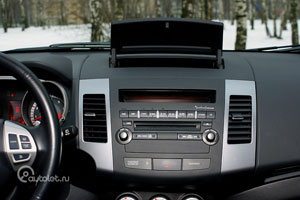

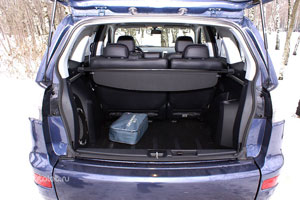
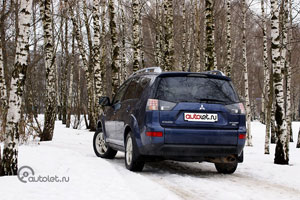
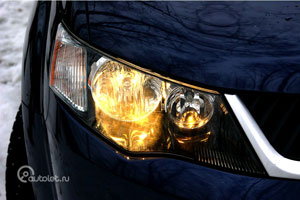

Source: Autolet.ru
Video Crash tests Mitsubishi Outlander (Airtrek) since 2007
Mitsubishi Outlander (Airtrek) test drive since 2007
Mitsubishi Outlander Crash Test (Airtrek) since 2007
Krassh Test: Detailed Information32%
Driver and passengers
17%
Pedestrians
35%
Children-passengers


